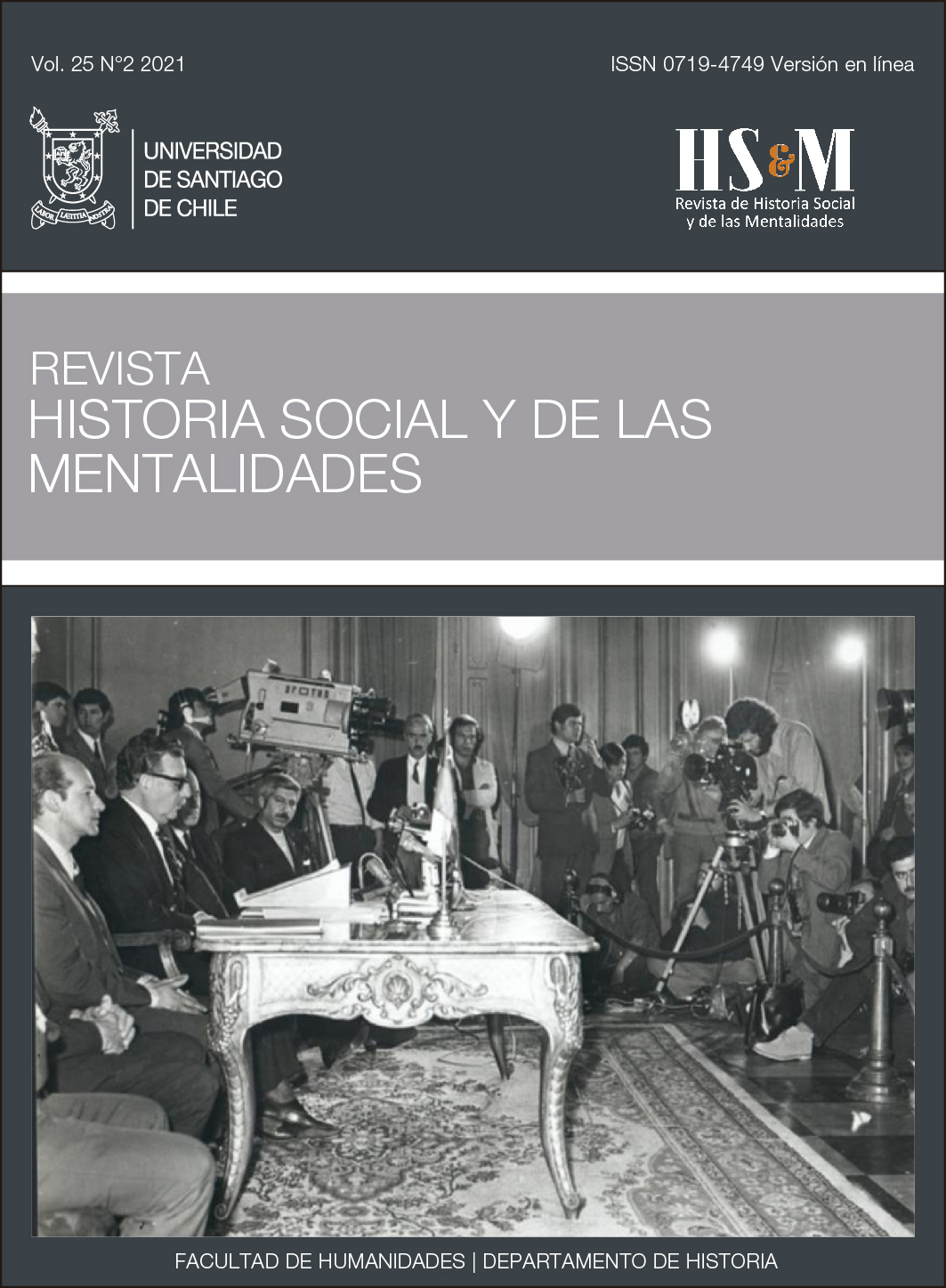THE MEDIA PRODUCTION OF “THE POOR OF THE CITY”: THE CASE OF THE RAMONA TELEVISION SERIES
DOI:
https://doi.org/10.35588/rhsm.v25i2.4904Keywords:
Television series, Popular movement, Chilean television, Chilean social historyAbstract
This article provides a close reading of the visual portrayals about “the impoverished inhabitants of the city” as a social movement. It does so by analyzing Ramona, a fiction television series broadcast by the Chilean public television in 2017 and 2018. The story is set in 1967 and it depicts a complex overview fueling what we call a visual common sense and media social memory about both the historical period and the phenomenon Ramona illustrates. The media production about “the impoverished inhabitants of the city” is more than one hundred years old and it has been represented by a plurality of languages, genres, styles, and cultural artifacts. Books, cartoons, films, or radio programming have promoted readings of popular characters, lives, and processes that have been key to the Chilean history and also a part of a cultural common sense. Ramona follows those previous paths at the same time it opens new media and interpretative clues, too.
Downloads
References
Anderson, Benedict. Comunidades imaginadas. Reflexiones sobre el origen y la difusión del nacionalismo. Fondo de Cultura Económica, 2000.
Antezana, Lorena y Mateos, Javier. “Construcción de memoria: la Dictadura a través de la ficción televisiva chilena”, Historia Crítica, no. 66, 2016, pp. 109-128. https://doi.org/10.7440/histcrit66.2017.06
Baron, Jaimie. The Archive Effect: Found Footage and the Audiovisual Experience of History. Routledge, 2014.
Buonano, Milly. El drama televisivo. Identidad y contenidos sociales. Gedisa Editorial, 1999.
Corro, Pablo, et al. Teorías del Cine Documental Chileno 1957-1973. Pontificia Universidad Católica de Chile, 2007.
De Ramón, Armando. Santiago de Chile. Editorial Sudamericana, 2000.
Espinoza, Vicente. Historia social de la acción colectiva urbana: los pobladores de Santiago, 1957-1987. EURE, 1998.
Garcés, Mario. Crisis social y motines populares en el 1900. Ediciones ECO/Documentas, 1991.
-----. Tomando su sitio. El movimiento de pobladores de Santiago, 1957-1970. LOM Ediciones, 2002.
Gramsci, Antonio. El materialismo histórico y la filosofía de Benedetto Croce. Juan Pablos Editor, 1975.
Guzmán, Juan Andrés y Marcela Ramos. La Guerra y la Paz Ciudadana. LOM Ediciones, 2000.
Hurtado, María de la Luz. Historia de la TV en Chile (1958 – 1973). Documentas-Céneca, 1988.
King, John. El Carrete mágico. Una historia del cine latinoamericano. TM Editores, 1994.
Latcham, Ricardo, et al. El Criollismo. Editorial Universitaria, 1956.
Larraín, Jorge. Identidad chilena. LOM Ediciones, 2001.
Lefebvre, Henri. La vida cotidiana en el mundo moderno. Alianza Editorial, 1956.
Martín-Barbero, Jesús. De los medios a las mediaciones. Editorial Gustavo Gili, 1987.
Martín-Barbero, J. y S. Muñoz. Televisión y melodrama. Tercer Mundo Editores, 1992.
Mattelart, Michelle. “Apuntes sobre lo moderno: una manera de leer la revista femenina ilustrada”. Ideología y medios de comunicación, compilado por M. Garretón, Amorrortu Editores, 1973, pp. 140-169.
McLuhan, Marshall y Quentin Fiore. El medio es el masaje. Un inventario de efectos. Paidós, 1988.
Memoria Chilena. “Minisitio: Manuel Rojas (1896-1973)” (http://www.memoriachilena.gob.cl/602/w3-article-3592.html) y “Minisitio: Literatura de bajos fondos” (http://www.memoriachilena.gob.cl/602/w3-article-3556.html).
Montalva, Pía. Morir un poco. Moda y sociedad en Chile 1960-1976. Catalonia, 2015.
Ortiz, Renato. Mundialización y Cultura. Alianza Editorial, 1997.
Paranaguá, Paulo Antonio (ed.). Cine documental en América Latina. Cátedra, 2003.
Pinto, Julio y Gabriel Salazar. Historia Contemporánea de Chile: Actores, identidad y movimiento, Volumen II. LOM Ediciones, 1999.
Rodrigo-Alsina, Miquel. La construcción de la noticia. Paidós, 1996.
Romero, José Luis. Latinoamérica. Las ciudades y las ideas. Siglo XXI Editores, 2007.
Romero, Luis Alberto. ¿Qué hacer con los pobres? Elite y sectores populares en Santiago de Chile, 1840-1895. Editorial Sudamericana, 1997.
Salazar, Gabriel. Violencia política popular en las “Grandes Alamedas”, Santiago de Chile 1947-1987. Ediciones SUR, 1990.
-----. Labradores, peones y proletarios. LOM Ediciones, 2000.
Salinas, Claudio y Stange, Hans. “Este cine chacotero... Impostura y desproblematización en las representaciones del sujeto popular en el cine chileno 1997-2005”. Cuadernos de Trabajo, Instituto de Comunicación e Imagen, Universidad de Chile, 2006.
Salinas, Claudio, Stange, et al. “¿Géneros o estrategias? Discursos históricos y cinematográficos en el cine chileno de ficción”, Aisthesis, no. 63, 2018, pp. 9-25. https://doi.org/10.7764/aisth.63.1
Salinas, M., et al. El Chile de Juan Verdejo. El humor político de Topaze 1931-1970. Editorial Universidad de Santiago, 2011.
Santa Cruz A., Eduardo. Las telenovelas puertas adentro. El discurso social de la telenovela chilena. LOM Ediciones, 2001.
-----. La prensa chilena en el siglo XIX. Patricios, letrados, burgueses y plebeyos. Editorial Universitaria, 2010.
-----. “Cine y sociedad en Chile en la década de 1940”. La mirada obediente. Historia nacional en el cine chileno, editado por C. Salinas y H. Stange, Editorial Universitaria, 2017, pp. 57-78.
Silva Castro, Raúl. Alberto Blest Gana. Editorial Zigzag, 1955.
-----. Baldomero Lillo (1867-1923). Nascimento, 1968.
Subercaseaux, Bernardo. Hist
oria de las ideas y de la cultura en Chile. Nacionalismo y Cultura. Tomo IV. Editorial Universitaria, 2007.
Verón, Eliseo. “Esquema para el análisis de la mediatización”, Revista DIÁ-LOGOS, no. 48, 1997, pp. 10-17.
Vial Correa, Gonzalo. Historia de Chile (1891-1973). La sociedad chilena en el cambio de siglo (1891-1920). Volumen I, Tomo II. Editorial Santillana del Pacífico, 1984.
Downloads
Submitted
2021-04-22Published
Issue
Section
License
Copyright (c) 2021 Revista de Historia Social y de las Mentalidades

This work is licensed under a Creative Commons Attribution-NonCommercial-NoDerivatives 4.0 International License.













